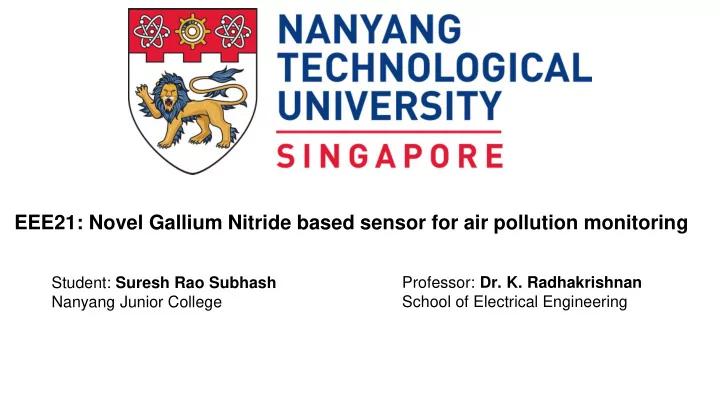

EEE21: Novel Gallium Nitride based sensor for air pollution monitoring Student: Suresh Rao Subhash Professor: Dr. K. Radhakrishnan Nanyang Junior College School of Electrical Engineering
Background
As the usage of the fossil fuels continues to rise, the world’s cities are becoming more polluted by air.
The World Health Organisation estimates that 4.2 million people die as a result of ambient air pollution each year.
The WHO has a limitation for Nitrogen Dioxide of 20 ppb
Dangers of NO 2 Gas Catalyses formation of acid rain Forms photochemical smog Damages the Respiratory system of a Biological body and the Environment!
Applications of Gas Sensors Gas Leak in Pipelines and in Industrial exhaust Vehicle exhaust systems Laboratories
❏ High Sensitivity ❏ Selectivity Qualities of a ❏ Fast Response time preferable gas ❏ Fast recovery time sensor ❏ Lifetime ❏ Energy consumption
Existing Compared to the existing metal oxide sensors, AlGaN/GaN HEMT based sensors possess Metal Oxide sensors vs 1. Higher electron mobility AlGaN/GaN 2. Wide operating temperature range HEMT sensors 3. Good chemical inertness and mechanical stability 4. Longer life expectancy
Aim of the project 1. Characterise the AlGaN/GaN HEMT based sensors for NO 2 gas sensing, by studying the effect of humidity, temperature and gas concentrations on sensitivity, response time and recovery time. 1. To understand the underlying sensing mechanism.
Ohm’s law states that the potential difference across an ideal conductor is Ohm’s Law - The proportional to the current through it. It is given by: V = IR , where V is the principle in the potential difference between two points project which include a resistance R.
Mechanism ● AlGaN/GaN heterostructure is formed when a wide band gap AlGaN barrier is grown coherently on the top of narrow band gap GaN channel. ● AlGaN grown layer on GaN buffer induces a polarization effect resulting in a positive charge on the AlGaN/GaN interface and a negative charge on the top of the AlGaN layer. T ● his differently charged areas result in forming an electric field inside the AlGaN layer. This makes the energy band, including the Fermi level, tilt towards the AlGaN/GaN interface. ● As the fermi level of GaN is lower than AlGaN, accumulated electrons in the lower AlGaN layer will flow to the top of GaN layer forming two dimensional electron gas (2DEG) .This process will cease when the Fermi levels of both materials will align with each other.
Mechanism ● The close proximity of 2DEG to the surface and high carrier density makes the device extremely sensitive to the surface charge. ● Platinum is used as a catalyst in AlGaN/GaN based sensor. ● When a gas compound diffuses to the interface, it results in a drain current response. The NO 2 gas is adsorbed on the platinum layer. - ions, which diffuses into grain ● Dissociation reaction occurs, causing the formation of the O 2 boundaries and are adsorbed at the adsorption sites at the AlGaN/GaN surface. ● These adsorption sites are electrically charged due to the Galium or Nitrogen vacancies in the AlGaN/GaN structure[3] and in turn affects the 2DEG density.
NO 2 gas sensing at room temperature ● The device was able to detect and react to the NO 2 gas exposure. ● The resistance of the device was not able to recover to baseline value completely, when the NO 2 gas supply was at 0 ppm concentration. ● The sensor was able to recover after heating it up to 300 ℃ and holding for a few minutes before cooling it down.
NO 2 gas sensing at 300 o C ● The sensor is able to recover completely for each concentration of the gas. ● The response time and the recovery time decreased with increasing temperatures, when exposed to differing concentrations of NO 2 . ● Measurable resistance change was observed even at a lower concentrations of NO 2 (0.5 ppm). ● Sensitivity of 5.35% was achieved for 10 ppm NO 2 concentration at 300 ℃ .
Relative Humidity NO2 gas at 40% humidity NO2 gas at 60% humidity
Results analysis ● The sensitivity of the sensor to the gas is higher at 60% relative humidity than the sensitivity at 40% relative humidity. ● The higher the humidity, the higher the sensitivity of the sensor to the gas. ● This, along with periodic heating, encourages the recovery of the sensor from NO 2 exposure. ● Furthermore, it prevents the baseline changes due to the change in the humidity level.
Conclusion ● In this project, it is experimentally verified that the presence of high temperature and humidity plays a major role in the proper and efficient functioning of the device. ● Moreover, The sensitivity of the fabricated sensor is 5.35% for 10 ppm concentration at 300 ℃ . ● At 300 o C, the response time of the sensor is less than 2.5 minutes for the lowest concentration of 0.5 ppm. ● Compared to existing metal oxide sensors, which has a recovery time of around one hour, the device uses much lesser time to recover, at just around 4 minutes. ● Hence, AlGaN/GaN HEMT has a good prospect for various applications as NO 2 gas sensor.
Thank you!
Recommend
More recommend